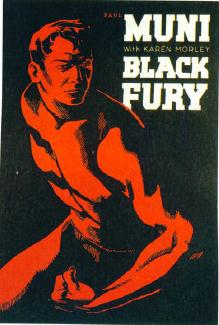Black Fury (film)
| Black Fury | |
|---|---|
 | |
| Directed by | Michael Curtiz |
| Written by | Michael A. Musmanno (story) Harry R. Irving (play) Abem Finkel Carl Erickson |
| Produced by | Hal B. Wallis (uncredited executive producer) Jack L. Warner (uncredited executive producer) |
| Starring | Paul Muni Karen Morley William Gargan |
| Cinematography | Byron Haskin |
Production company | |
| Distributed by | Warner Brothers |
Release date |
|
Running time | 94 minutes |
| Country | United States |
| Language | English |
Black Fury is a 1935 American crime film starring Paul Muni, Karen Morley, and William Gargan. It was adapted by Abem Finkel and Carl Erickson from the short story "Jan Volkanik" by Judge Michael A. Musmanno and the play Bohunk by Harry R. Irving.[1] Directed by Michael Curtiz, the plot is based on a historic incident during Pennsylvania walk-out in 1929, in which John Barkowski, a striking coal miner, was beaten to death by private company police.[2]
In 1936, at the 8th Academy Awards, Muni was not officially nominated for the Academy Award for Best Actor, but he came in second on the basis of write-in votes, which were allowed that year.
Plot
Set in Pennsylvania coal country, the film tells the story of Joe Radek (Paul Muni), a miner of Slavic background. Upset after an argument with his girlfriend Anna Novak (Karen Morley), he drinks and attends a union meeting, where he acts as a catalyst to splitting the union members into radical and moderate factions; radically inclined miners decide to walk out and strike, the others led by Radek's best friend Mike Shemanski (John Qualen) stay at work. Meanwhile, the company brings in a private police force cobbled out of thugs by a Pinkerton-type detective agency.
One night, when three drunk company cops are trying to violate Shemanski's daughter, both friends reunite in defending her honor. During the fight, Shemanski is killed by McGee (Barton MacLane), and Radek is injured and hospitalized. While he is recovering, the strike ends with no results and Shemanski's murder stays unpunished. Angry Radek collects dynamite and provision and decides to start his own underground protest by hiding in the mine during the daytime and blowing up company property at night. His exploits draw the national attention after being reported by the media. Corrupted company cops are trying to catch with Radek in the mine; he fights back with dynamite sticks and accidentally seals himself and Shemanski's murderer McGee in a mine tunnel. After an epic fight Radek emerges from the mine with subdued company policeman to deliver him to justice, and as a winner in the court of public opinion he is able to influence more favorable union contract for his mining buddies, making amends with his girlfriend as well.[1][3]
Cast
- Paul Muni as Joe Radek
- Karen Morley as Anna Novak
- William Gargan as Slim Johnson
- Barton MacLane as McGee
- John Qualen as Mike Shemanski
- J. Carrol Naish as Steve Croner
- Tully Marshall as Tommy Poole
- Henry O'Neill as John W. Hendricks
- Joseph Crehan as Johnny Farrell
- Mae Marsh as Mrs. Mary Novak
Production
Judge Michael Musmanno prosecuted three company police for the murder of John Barkowski, "an innocent miner," at Imperial, Pennsylvania, in 1929. Later he wrote a short story changing the name of the miner, "Jan Volkanik," about the incident. This and the play Bohunk, by Harry R. Irving, were adapted for the film in a screenplay written by Abem Finkel and Carl Erickson.[3] In Black Fury, John Barkowski is fictionalized as Mike Shemanski. In 1966, Musmanno published a novel version of the screenplay also named Black Fury.
Reception
Andre David Sennwald Jr. of the The New York Times wrote in April 1935, "Magnificently performed by Paul Muni, it comes up taut against the censorial safety belts and tells a stirring tale of industrial war in the coal fields."[3] He described it as "the most notable American experiment in social drama since Our Daily Bread.'"[3] The film was banned in several American states as inciting social conflict.[2]
Honors
- In 1936, a year in which the Academy Awards accepted write-in votes, Paul Muni came in second for Best Actor for his performance.[3]
References
- ^ a b Herzberg, Bob. The Left Side of the Screen: Communist and Left-Wing Ideology in Hollywood, 1929-2009. Jefferson, N.C.: McFarland, 2011, p. 42-46.
- ^ a b Robertson, James C. The Casablanca Man: The Cinema of Michael Curtiz. London: Routledge, 1993, p. 31-32.
- ^ a b c d e Andre Sennwald. Movie Review: Black Fury (1935) Paul Muni in the Coal-Mine Melodrama "Black Fury," at the Strand -- "Four Hours to Kill.", The New York Times, 11 April 1935, accessed 12 September 2013.
External links
- Black Fury at the AFI Catalog of Feature Films
- Black Fury at the TCM Movie Database
- Black Fury at IMDb
- Black Fury at AllMovie
